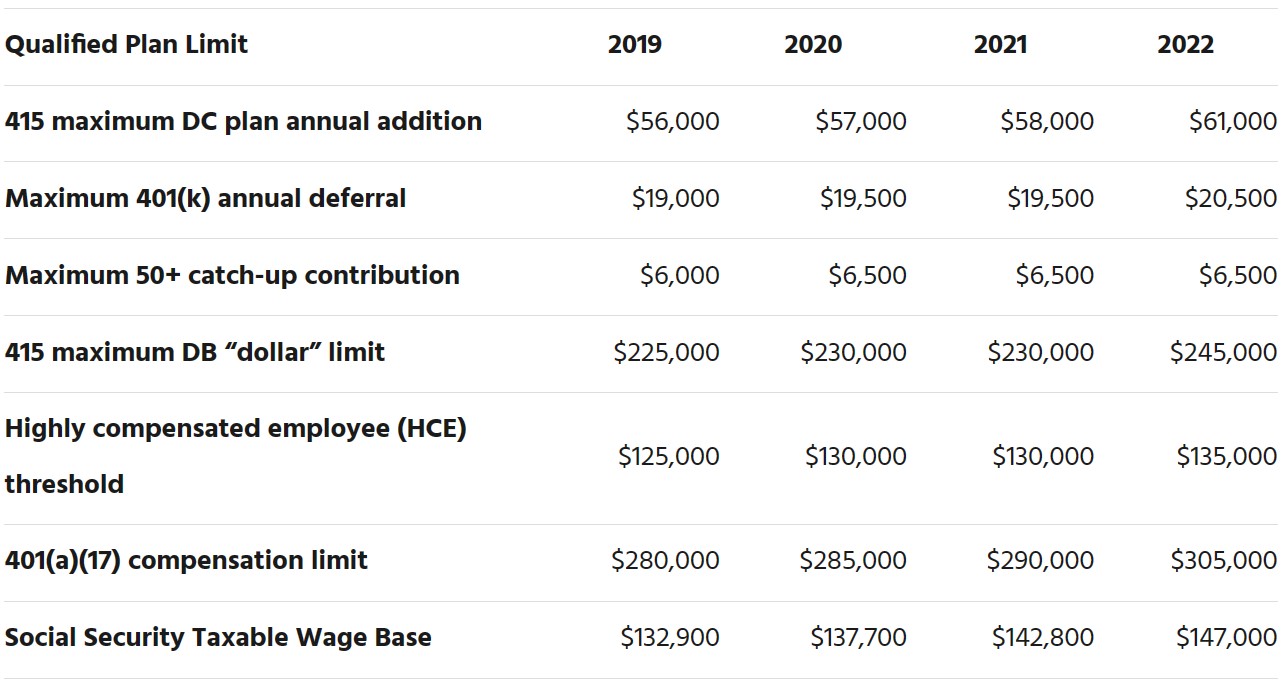After years or relatively low and stable inflation, the 2022 retirement plan benefit limits just announced in IRS Notice 2021-61 stand apart with a notable increase due to the higher inflation seen over the last few months.
Broadly speaking, the limit increases will lead to higher qualified plan benefits for highly-paid employees while increasing tax-deferred savings options for DC plan participants. Here is a table of the main limits, followed by our analysis of the practical effects for both defined contribution (DC) and defined benefit (DB) plans.

Changes affecting both DB and DC plans
- Qualified compensation limit increases to $305,000. The 401(a)(17) compensation limit has steady increased $5,000 in each of the last three years, so this year’s $15,000 is significant. Highly-paid participants will now have more of their compensation “counted” towards qualified plan benefits and less towards non-qualified plans. This could also help plans’ nondiscrimination testing if the ratio of benefits to compensation decreases.
- HCE compensation threshold remains at $135,000. While this limit did increase $5,000 compared to last year, employers may find that more participants meet HCE compensation criteria if recent wage inflation outpaces general inflation. This could have two direct outcomes:
- Plans may see marginally worse nondiscrimination testing results (including ADP results) if there are more HCEs. It could make a big difference for plans close to the pass/fail line.
- More HCEs means that there are more participants who must receive 401(k) deferral refunds if the plan fails the ADP test.
Note that there is a “lookback” procedure when determining HCE status. This means the 2023 HCE determination is based on 2022 compensation and the $135,000 threshold.
DC-specific increases and their significance
- The 401(k) deferral limit increases from $19,500 to $20,500. The 401(k) deferral limit has only grown modestly over the past few years, so savers will welcome the $1,000 increase from 2021 to 2022.
- 401(k) “catch-up” limit remains $6,500. Participants age 50 and older are treading water with a flat $6,500 cap in 2022. This means they can effectively get a maximum DC deduction of $67,500 ($61,000 + $6,500).
- The annual DC 415 limit increases from $58,000 to $61,000. This is a substantial increase that provides employers with more flexibility to increase their maximum profit sharing allocations under the higher total cap. Individuals can potentially get up to $40,500 from employer matching and profit sharing contributions ($61,000 – $20,500) if the employer maximizes their DC plan deductions.
DB-specific increases and their significance
- DB 415 maximum benefit limit (the “dollar” limit) increases to $245,000. After a period of steady increases and then pausing last year, the DB §415 dollar limit leaps ahead in 2022. The effect is that individuals who have very large DB benefits (say, shareholders in a professional firm cash balance plan) could see a deduction increase if their benefits were previously constrained by the 415 dollar limit.
Social Security wage base and integrated plans
- Social Security Taxable Wage Base increases to $147,000. This is a $4,200 increase from last year’s base. A higher wage base can reduce the rate of pension accruals and DC allocations for highly-paid participants in integrated pension and profit sharing plans that provide higher rates above the wage base.


